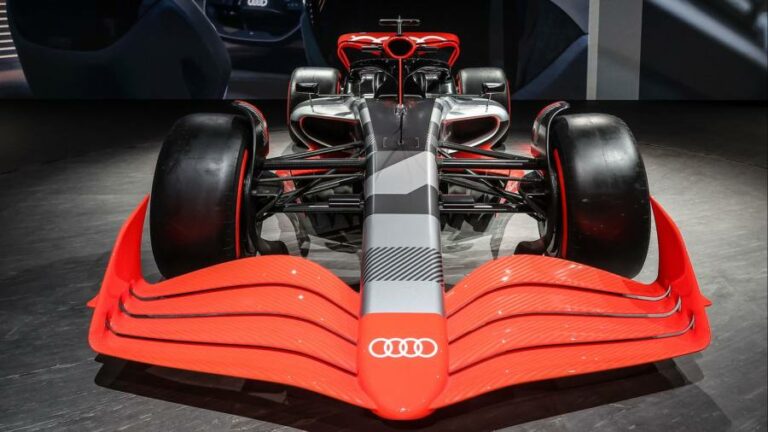The teams on the Formula One grid race 23 times a year. But the sport, as a whole, is in a one-off race of its own: to be net zero in carbon emissions by 2030.
Of all the work being done to reach that goal, the vast majority is aimed at reducing outputs from the factories of the 10 teams, as well as the personnel, public and freight travel to race locations around the world. These were estimated in 2018 at 256,551 tonnes of CO₂.
Four years on, the sport is scything through those numbers. For example, Mercedes cut emissions from race trucks in Europe by about 90 per cent in 2022, by using biofuels and investing in sustainable aviation fuel, among other programmes. There are six years to go to the finish line, when an audit will reveal whether the goal has been reached.
But, despite all these advances, to F1’s millions of fans — and its critics — the most visible part of the drive to sustainability will be what happens with the racing cars on the track. While these account for less than one per cent of all F1’s emissions, they are the most visible element of the sport, and the most relevant to the wider industry. Imagine the optics of F1 developing 100 per cent sustainable high-performance engines that power the fastest cars in the world — and letting that technology trickle down to everyday motoring.
F1 and its governing body, the Federation Internationale de l’Automobile, decided that this could be achieved from 2026 onwards through power units that are a 50-50 combination of a small capacity internal combustion engine with an electric hybrid system, each generating 350kW of power. This is a significantly higher proportion of electric power than the current hybrid engines. And they will run on zero emission e-fuels. F1 will use its huge global platform to showcase these fuels, which will, in due course, become available at retail pumps around the world.
“It’s the same reality for all of us, to stay relevant as a team and relevant as a sport,” says Toto Wolff, CEO of the Mercedes F1 team. “Sustainability needs to be all encompassing. Our technologies need to be utilised for the good of the world. The plan is to make an efficient, yet high performance fuel available at the pump stations, not a few litres of rocket fuel for F1 engines.”
On the face of it, this runs counter to the direction of travel. Governments are mandating the abolition of internal combustion engines in new vehicles — some, by as soon as 2030. But Wolff says that the technology being developed in F1 should bridge the gap while the volume of electric vehicles on the road and the infrastructure to charge them reach critical mass.
“The world is moving towards electric mobility and there is no doubt about it. We will soon see all of us travelling electric in an urban environment in affluent cities. That will eventually expand all over the world. But, in between, there’s probably a transition period of 20 years, where cars will still be powered by combustion engines. Our calculation is, in 2035, there will be one and a half billion pure combustion engines around the world. If we can participate in that energy transition by providing hybrid technology and fuel technology for this huge mass market, that is beneficial.”
Formula 1 chief technical officer Pat Symonds says, “The advanced sustainable fuel for 2026 has deliberately been designed to be “drop-in”, meaning it can be used in a standard road car. By using our platform to accelerate the development of advanced sustainable fuels, proving their effectiveness and that production can be done at scale, we believe we can have an impact far beyond our paddock, in terms of decarbonisation.”
The FIA published the regulations for the 2026 engines last August. The goal was to encourage new manufacturers to enter by making power units cheaper to design and build. At the same time, they levelled the playing field by simplifying the current engines, so new entrants could be competitive from 2026 onwards. This was achieved by removing the complex heat regeneration units currently in use. It has attracted one of Mercedes’ main automotive rivals, Audi, to enter in 2026. It has also led to Honda reversing an earlier decision to withdraw. And it has brought back Ford — a long time F1 competitor from the 1960s to the 2000s — which will put its blue oval badge on the Red Bull Powertrains, built in Milton Keynes, that power the reigning champion team.
If Ford is taking the F1-lite approach, Audi is going all in; buying the Swiss based Sauber team, rebranding it as Audi, and making its own engine.
“The key to getting involved in the world’s most popular racing series is the clear plan to become more sustainable and cost-efficient,” explains Oliver Hoffmann, chief technical officer of Audi AG.
“Formula One has set itself the goal of being carbon-neutral as a racing series by 2030. I see an ideal fit with Audi. Formula One is both a global stage for our brand and a highly challenging development laboratory. The combination of high performance and competition is always a driver of innovation and technology transfer in our industry.
“With the new regulations as of 2026, now is the time for us to get involved.”


